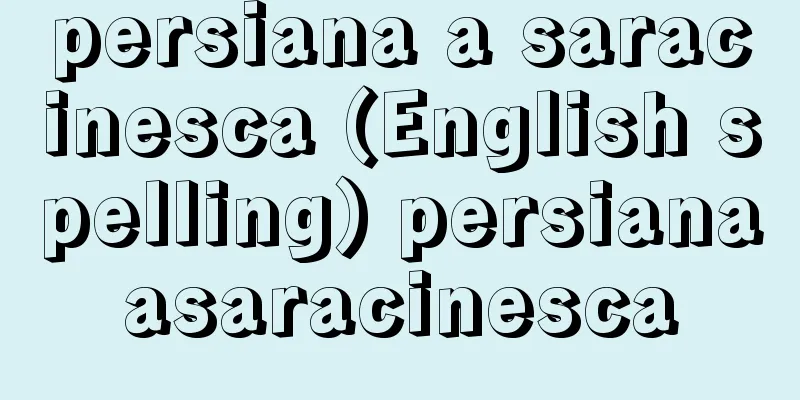Luxury items - luxury items

|
Something that is not primarily intended for nutritional intake, but is used for the enjoyment of flavors, pleasant stimuli, etc. Human beings have not necessarily taken in food solely out of physiological necessity. The idea that something is consumed because it contains nutrients has become dominant in modern times, and in a sense, all food and drink are consumed only by habit, and it can be difficult to judge whether people consume something because they like it. Therefore, when something is considered a luxury item, it is often only relative. Currently, according to the standards of Western nutritional science, things that do not have nutritional significance are usually treated as luxury items. However, the "luxury items" used by each ethnic group are not necessarily considered to be of only secondary importance by them. [Hiroyuki Kurita] General FavouritesLuxury goods generally have stimulating, intoxicating or aromatic properties, and include foods and beverages such as tea, coffee, soft drinks and sweets, as well as chewing substances such as gum and chewing tobacco, and snuff such as tobacco. Spices that stimulate the appetite are sometimes included in luxury goods. Many substances that have stimulating or intoxicating properties originally had special religious or ceremonial significance, or medicinal significance, and in most cases they are thought to have lost their special significance and become luxury goods. The types of recreational goods vary according to ethnic groups and cultures, but many have spread to wide areas through the spread of information and trade and are now used all over the world. Tobacco, which originated in South America, is smoked in almost every country, and cocoa, which also originated in South America, is widely consumed. Tea, which originates in Asia, and coffee, which originates in Ethiopia, are also enjoyed worldwide. Various types of alcoholic beverages are brewed all over the world, including alcohol made from grains and potatoes, alcohol made from fruit, and alcohol made from sap, milk, honey, and other ingredients. With the exception of parts of Oceania and North America, there are only a few areas where alcoholic beverages were not consumed traditionally. [Hiroyuki Kurita] Regional hobbiesIn addition to these typical luxury items, there are various other luxury items unique to each region around the world. Betel chewing is practiced in areas from the East African coast to India, Southeast Asia, and Oceania. There are various ways to chew betel, but the basic method is to wrap the betel nut (a tall palm tree) and lime in a betel leaf (a climbing shrub in the pepper family) and chew it. When chewing this, the inside of the mouth turns bright red, but there is a kind of stimulation with a refreshing feeling. In addition, in contrast to alcoholic drinks, a drink called kava, which has a sedative effect, is consumed in parts of Oceania. The roots of kava (a shrub in the pepper family) are dried and crushed, and the ingredients are dissolved in water and drunk. It does not contain alcohol but has an intoxicating effect. Kava is drunk in groups, and originally had religious and ceremonial significance. There are various regulations on how to make it and how to drink it. In South America, yerba mate and guarana, which contain caffeine, are consumed in the same way as tea and coffee. Yerba mate is made from the dried and finely ground leaves of a shrub of the Ilex family. Mate and sugar are placed in a jar-shaped container, and hot water or milk is poured over it, and the resulting drink is consumed through a straw. Native South Americans have been using yerba mate since ancient times, but it was spread to surrounding areas by Christian missionaries. Guarana is a vine plant of the Sapindaceae family, and its seeds are dried, crushed, mixed with water, kneaded, and then dried again. The seeds are then grated, sugar is added, and the mixture is dissolved in water for consumption. Coca leaves, the raw material for cocaine, have been used by indigenous South Americans for a long time. When dried coca leaves are chewed with lime, the strong anesthetic effect of the cocaine helps people to endure cold, hunger, and fatigue, and increases their motivation to work. In the Andes, it has been called "sacred coca" since the Inca Empire and has been used as a local anesthetic. Coca leaves also play an important role in divination and healing rituals among indigenous South Americans, along with tobacco. Another plant that is used in a similar way to coca leaves is khat (a shrub of the Celastraceae family), native to Ethiopia. Like coca leaves, khat leaves are mainly chewed directly to utilize their anesthetic properties, but dried leaves can also be used like tea, in which case they are sometimes called khat tea. In West Africa, kola nut, which contains caffeine, is used as a recreational drug. Kola is a tall tree of the Sterculiaceae family native to tropical Africa, and its seeds are eaten raw by chewing them. Kola nut is often linked to religious ceremonies and is an important trade commodity throughout West Africa, transported to desert areas for consumption. The above various recreational substances have become recreational items as their religious, ceremonial or medicinal meanings due to their stimulating and intoxicating properties have faded. Other substances with intoxicating properties include a type of cactus called peyote used in the peyote rituals of Native North Americans, a plant called yohe used in the yohe rituals of Native Central and South Americans, poisonous mushrooms used by Native Central and South American and Siberian shamans to enter a state of possession or loss of soul, datura (a plant of the nightshade family) used in Latin America, South Asia and Africa to enter a state of possession or loss of soul or as a kind of magical medicine, and many others have been reported from all over the world, but most of them are used for ritual or medicinal purposes and have not become commonplace, and have not yet become recreational items. [Hiroyuki Kurita] Source: Shogakukan Encyclopedia Nipponica About Encyclopedia Nipponica Information | Legend |
|
栄養摂取を主要な目的とせず、香味や快い刺激などを楽しむため用いるもの。人類はかならずしもその生理的必要性のみから物を摂取してきたのではない。栄養素が含まれているから摂取するという考え方は近代になって支配的になってきたものであり、ある意味で、飲食物はすべて習慣によって摂取されているにすぎないし、人々がそれを好んでいるから摂取するのかどうか判断することも困難な場合がある。したがって、なにかを嗜好品とみなす場合、それはしばしば相対的なものにすぎない。現在では、西欧的な栄養学の尺度に従って、通例、栄養学的に重要な意味をもたないようなものが嗜好品として扱われる。しかし、各民族の用いている「嗜好品」が、かならずしも彼らによって副次的な重要性しかもたないものとして考えられているとは限らない。 [栗田博之] 一般的な嗜好品嗜好品は一般に、刺激性、催酔性、芳香性などをもち、茶、コーヒー、清涼飲料、菓子類などの飲食物のほかに、ガム、噛(か)みたばこなどの噛み料、たばこなどの嗅(か)ぎ料が含まれる。食欲増進を目的とする香辛料も嗜好品に含めることがある。刺激性、催酔性などをもつものは、本来、特別な宗教的・儀礼的な意味、あるいは薬用的な意味をもったものが多く、ほとんどの場合、それが特別の意味合いを失って、嗜好品化してきたと考えられる。 嗜好品の種類は民族や文化によってさまざまであるが、伝播(でんぱ)や交易によって、広範な地域に広がって世界各地で用いられている嗜好品も多い。南アメリカ原産のたばこはほとんどすべての国で喫煙されており、同じく南アメリカ原産のカカオも広く飲食されている。また、アジア原産の茶、エチオピア原産のコーヒーも全世界的に愛飲されている。穀類や芋類を原料とする酒、果実類を原料とする酒、そのほか樹液、乳、蜂蜜(はちみつ)などを原料とする酒など、世界各地ではさまざまな種類のアルコール性飲料が醸造されており、オセアニアと北アメリカの一部の地域を除き、元来アルコール性飲料を飲用していなかった地域は限定されている。 [栗田博之] 各地に固有な嗜好品これらの代表的な嗜好品以外にも、世界各地にはその地域に固有のさまざまな嗜好品が存在している。東アフリカ海岸部から、インド、東南アジア、オセアニアにかけての地域では、キンマ噛みが行われている。キンマ噛みにはいろいろな方法があるが、ビンロウ(ヤシ科の高木)の実と石灰をキンマ(コショウ科のつる性低木)の葉で包み噛むというのが基本である。これを噛むと口の中は真っ赤になるが、一種の爽快(そうかい)感を伴う刺激がある。また、アルコール性飲料とは逆に、鎮静作用をもったカバとよばれる飲料がオセアニアの一部で飲用されている。カバ(コショウ科の低木)の根を乾燥させたものを突き砕き、成分を水に溶かし出したものが飲用され、アルコール分を含んでいないが催酔性をもつ。カバは集団で共飲するものであり、本来は宗教的・儀礼的な意味をもっていた。そして、その作り方、飲み方にはさまざまな規定がみられる。 南アメリカでは、茶やコーヒーと同様、カフェインを含んだマテ茶やガラナが飲用されている。マテ茶はモチノキ科の低木の葉を乾燥させ細かくしたもので、壺(つぼ)状の容器にマテ茶と砂糖を入れ、熱い湯や牛乳を注ぎ、これをストローで飲む。南米先住民は古くからマテ茶を用いていたが、キリスト教の宣教師によって周辺地域にも広められた。ガラナはムクロジ科のつる性植物で、その種子を乾燥させ突き砕き、水を加えて練り固め、ふたたび乾燥させる。これを削って砂糖を加え水に溶かしたものが飲用される。 コカインの原料となるコカの葉も、南米先住民によって古くから利用されてきた。乾燥させたコカの葉を石灰とともに噛むと、コカインによる強い麻酔作用があり、寒さや空腹と疲労に耐え、労働意欲を高進させるという。アンデス地帯では、インカ帝国以来「聖なるコカ」とよばれ、局部麻酔薬として用いられたこともあった。南米先住民の占いや治療儀礼などにおいても、コカの葉は、タバコと並んで重要な位置を占めている。コカの葉と似た利用のされ方をするものに、エチオピア原産のカート(ニシキギ科の低木)がある。コカの葉のようにカートの葉を直接噛み、その麻酔性を利用するという利用法が主だが、乾燥させた葉を茶と同様に利用することもあり、この場合にはカート茶とよばれることもある。 西アフリカでは、カフェインを含むコーラの実が嗜好品として利用されている。コーラは熱帯アフリカ原産のアオギリ科の高木で、その種子をなまのまま噛み砕き食べる。コーラの実は宗教的儀礼と結び付けられていることが多く、西アフリカ一帯での重要な交易品であり、砂漠地帯まで輸送され、消費されている。 以上のさまざまな嗜好品は、その刺激性、催酔性による宗教的・儀礼的あるいは薬用的な意味合いが薄れ、嗜好品化が進んだものである。このほか催酔性をもつものとして、北米先住民のペヨーテ儀礼で用いられる、ペヨーテとよばれるサボテンの一種、中南米先住民のヨヘ儀礼で用いられるヨヘとよばれる植物、中南米先住民、シベリア先住民などでシャーマンが憑依(ひょうい)・脱魂状態に入るために用いる毒キノコ類、中南米、南アジア、アフリカなどで、やはり憑依・脱魂状態に入るため、あるいは、ある種の呪薬(じゅやく)として用いられるダトゥラ(ナス科の植物)、その他さまざまなものが世界各地から報告されているが、いずれも儀礼的・薬用的な意味で利用される場合がほとんどで、常用されるに至っておらず、嗜好品化は進んでいない。 [栗田博之] 出典 小学館 日本大百科全書(ニッポニカ)日本大百科全書(ニッポニカ)について 情報 | 凡例 |
<<: Magnetic steel piece - magnetic link
Recommend
Garnish - to add something
〘Ta Sa Lower 1〙 Tsukea wa/su 〘Ta Sa Lower 2〙① To b...
Oninoyagara (Demon's Arrow) - Oninoyagara (English name) Gastrodia elata Blume
A large saprophytic orchid with a flower stalk tha...
Kappa Marries Into a Baby - Kappa Mukōiri
...Comparing this "Monkey Bride" with t...
Panel painting mural - Itaehekiga
…(b) Wooden Walls Wooden wall murals, which are m...
Otto, K. - Oops
...His popular works, intended as entertainment, ...
Gasser's ganglion - Gasser's ganglion
…This nerve is the thickest of the cranial nerves...
Sidgwick, NV (English spelling) SidgwickNV
…GN Lewis and I. Langmuir proposed the eight-corn...
Storehouse - Kurayashiki
In the Edo period, storehouses were built by feud...
Nutritional requirements - eiyoushoyoryo
The amount of energy and nutrients that is desirab...
Sedimentary facies
Within a group of strata, the strata can be divid...
Umbilical Tower - Umbilical Tower
...There are two methods: the assembly of the ent...
Shakya ye shes (English spelling) Shakyayeshes
...One of the four great monasteries of the Gelu ...
《Martian Invasion》
Born in Wisconsin. Obsessed with theater, he form...
Fermi
Italian physicist. He obtained his doctorate from...
Blackboard - kokuban (English spelling) blackboard
A notice board on which letters and drawings are ...









